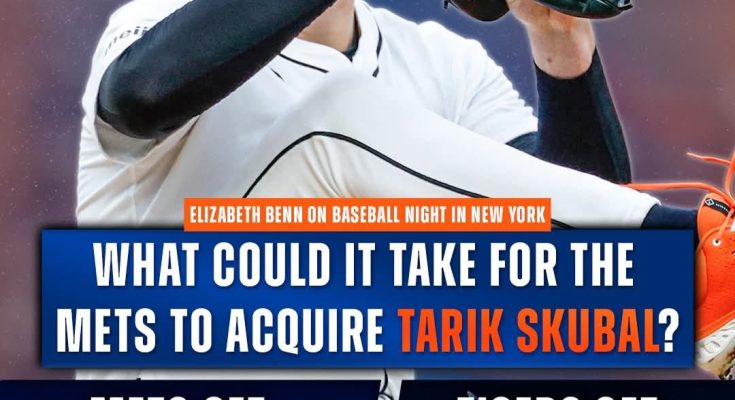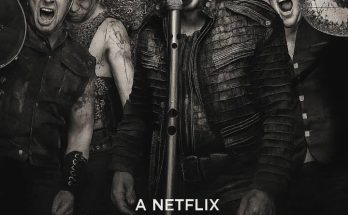When a name like Tarik Skubal enters trade conversations, the baseball world stops to take notice. The Detroit Tigers’ ace has become one of the most dominant left-handers in Major League Baseball, a legitimate Cy Young contender with electric stuff and elite command. So, when Elizabeth Benn suggested on Baseball Night in New York that the Mets could make a run at Skubal, the idea instantly sparked intrigue — and debate — across the sport. But the big question that followed was simple: how much would it actually cost the Mets to land him?
Joe DeMayo of SNY later weighed in with the Mets’ prospect rankings, giving some clarity to what kind of package the team could realistically offer. It’s no small task to pry away an ace like Skubal, especially one under team control for multiple years and just entering his prime. Detroit has no incentive to move him cheaply. The Tigers have finally begun to show progress in their rebuild, and Skubal has been the centerpiece of their pitching staff — a symbol of the franchise’s transition toward competitiveness. For any deal to materialize, the Mets would have to put together one of the most aggressive prospect packages in recent memory.
Tarik Skubal, 27, is the kind of pitcher franchises build around. This season, he’s emerged as one of baseball’s most valuable arms, dominating opponents with a high-velocity fastball that sits in the upper 90s, a devastating changeup, and a sharp slider that neutralizes both lefties and righties. His advanced metrics—elite strikeout rates, strong ground-ball percentages, and consistent command—paint the picture of a complete pitcher who’s still improving. Add to that several years of team control before free agency, and his trade value skyrockets. Any acquiring team would be getting not only an ace but a cost-controlled one in his prime years, a combination every front office covets.
For the Mets, the logic behind pursuing Skubal makes sense. Despite having one of the highest payrolls in baseball, New York’s rotation has struggled with injuries, inconsistency, and long-term uncertainty. Kodai Senga has battled setbacks, José Quintana’s age raises durability questions, and the younger arms haven’t yet established themselves as dependable starters. The Mets are trying to balance win-now aspirations with a sustainable future, and a trade for Skubal would accelerate their timeline while aligning with owner Steve Cohen’s win-at-all-costs mentality.
However, a trade like this comes with serious consequences. To land a frontline pitcher with Skubal’s profile, the Mets would have to dip deep into their farm system—something that has been gradually rebuilt after years of depletion. Joe DeMayo’s updated prospect rankings make it clear that the Mets finally have a promising wave of talent on the way, headlined by outfielders Drew Gilbert and Jett Williams, catcher Kevin Parada, and shortstop Luisangel Acuña. Each of those players represents a cornerstone in the team’s future plans. But if Detroit were to even listen to offers, at least two of those top-tier names would almost certainly have to be included.
Benn’s trade proposal reportedly outlined a massive haul centered around Jett Williams, Kevin Parada, and possibly a high-ceiling pitcher like Christian Scott or Blade Tidwell. Such a package would mirror the kind of blockbuster deals that have defined baseball’s recent trade history — the kind of all-in move we saw when the Padres landed Juan Soto or the Astros acquired Justin Verlander. Detroit, sitting at a crossroads between rebuilding and competing, would only pull the trigger if it could restock its farm with multiple top-100 prospects, including at least one potential franchise cornerstone.
From Detroit’s perspective, dealing Skubal would be painful but justifiable if the return were overwhelming. Williams, for example, is one of the most exciting young prospects in baseball. His elite speed, defensive versatility, and plate discipline make him a future leadoff hitter in the mold of Mookie Betts or Jose Altuve. Parada, meanwhile, is a polished catcher with big-league power potential and the kind of offensive ceiling that’s rare for the position. Add in a young pitcher like Tidwell—whose fastball-slider combination projects as mid-rotation or better—and Detroit could theoretically turn one star into three future building blocks.
Still, for the Tigers, the calculus is tricky. Skubal isn’t just their ace—he’s their identity. After years of searching for stability, Detroit finally found a true homegrown star who embodies their rebuild’s success. Trading him now could alienate fans and signal another reset just as the club seems ready to take the next step. Yet the Tigers’ front office, led by Scott Harris, is pragmatic. They know pitching can be fragile, and the opportunity to sell high might not always be there. If the Mets or another contender is willing to overpay with multiple top prospects, it could be difficult to resist.
For the Mets, though, the risk runs both ways. Trading away that much young talent would essentially mortgage the future for a shot at winning in the near term. Skubal’s presence would instantly upgrade the rotation, giving the team one of the best left-handed starters in baseball. But if injuries struck again or if the roster still fell short of postseason success, the move could look reckless in hindsight. New York has been down this road before—most recently with the failed pursuits of aging stars and short-term fixes. This time, the front office must decide whether Skubal represents a foundation piece or another fleeting gamble.
The financial implications are also notable. Skubal is still under arbitration control, meaning his salary remains team-friendly compared to free-agent aces. For Cohen, this makes the acquisition even more appealing: a Cy Young-caliber pitcher at a fraction of the cost of a frontline free agent like Corbin Burnes or Max Fried. That flexibility would allow the Mets to continue building around Pete Alonso, Francisco Lindor, and Brandon Nimmo without exceeding future luxury tax thresholds. From a pure business standpoint, Skubal’s contract status is gold.
But does the proposed trade make sense from a baseball perspective? In many ways, yes. Skubal is the kind of elite arm that can transform a team’s rotation overnight. His combination of velocity, control, and mound presence fits perfectly in the pressure-cooker environment of New York. He’s shown no fear pitching in high-leverage situations and has consistently improved each season since debuting. Moreover, the Mets have a window of contention that hinges on maximizing the primes of Lindor, Alonso, and Nimmo. Adding Skubal would extend that window and potentially push the club into legitimate championship contention in 2026 and beyond.
Yet, losing multiple top prospects—especially Jett Williams—could hurt in the long run. The Mets have spent years replenishing their system under the leadership of Billy Eppler and now David Stearns. Those prospects represent the next generation of Mets stars, and parting with them could leave the team vulnerable in a few years when their veteran core begins to age. This is the classic dilemma facing every big-market contender: go all in now or maintain balance for the future.
If the Tigers demanded both Williams and Parada, plus one or two pitching prospects, it would easily rank among the most expensive trades in recent memory. The Mets’ farm system, though improved, doesn’t have endless depth. Trading three or four of their top six prospects would essentially strip the upper levels bare. For Detroit, that’s precisely why such a deal would appeal—they could instantly reshape their entire minor league hierarchy with high-upside talent ready to debut within two years.
As for fan reaction, it would be mixed. Mets fans, desperate for stability and postseason glory, would likely welcome Skubal with open arms. They’ve endured years of rotation chaos and would love to see a young, dominant ace take the mound every fifth day. But the loss of beloved prospects could sting, especially if Williams or Parada blossoms elsewhere. The Tigers fanbase, meanwhile, might see the move as a betrayal unless the return package pays off in spectacular fashion. Losing Skubal would hurt deeply; he’s become the face of their rise.
In the broader context of baseball economics and roster building, this hypothetical trade underscores the growing value of controllable pitching. Teams no longer trade young, elite starters lightly. The cost of acquiring one is often astronomical, and only franchises with both financial muscle and a strong farm system—like the Mets—can even entertain the conversation. Skubal’s name in trade rumors speaks more to the boldness of speculation than to Detroit’s actual willingness to move him, but it’s not unthinkable. Every player has a price, and with a creative offer, the Mets could at least make the Tigers pause.
Ultimately, Elizabeth Benn’s suggestion serves as an intriguing thought experiment about ambition and cost. If the Mets truly want to shift their narrative from underachievers to perennial contenders, moves like this may be necessary. Joe DeMayo’s prospect insights make it clear that New York has the assets to pull off such a blockbuster. But it would take courage — and a belief that Skubal could be the missing piece that finally delivers October glory to Queens.
Would the agreement be worth it? In the short term, absolutely. Skubal would give the Mets a legitimate chance to contend for the National League East and beyond. His presence could anchor a rotation that desperately needs reliability, while his youth ensures that the team’s competitive window remains open for years. But in the long run, if the traded prospects develop into stars elsewhere, the deal could come back to haunt them.
That’s the paradox of big trades: success is often measured not just by what’s gained, but by what’s lost. For the Mets, the allure of Tarik Skubal represents both a dream and a danger — a chance to seize control of their destiny, or a gamble that could redefine their future for better or worse.
If Benn’s proposal ever became reality, it would be a defining moment in modern Mets history. And if Skubal were to don the blue and orange, take the mound at Citi Field, and deliver ace-level dominance under the New York lights, the price—no matter how steep—might just feel worth every prospect sacrificed.


